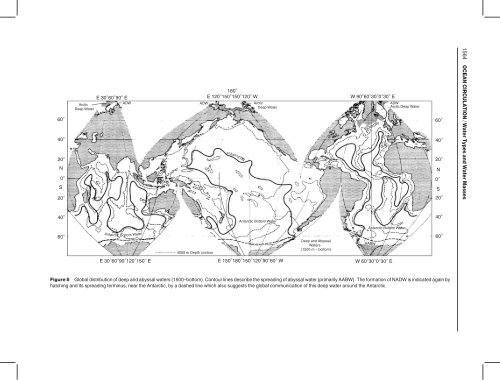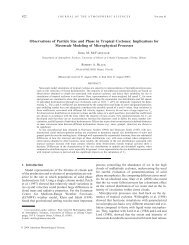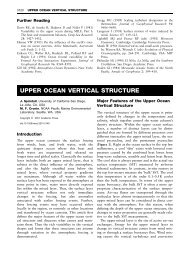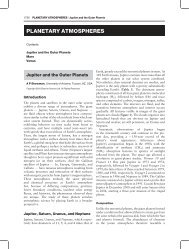Ocean Circulation - Water Types and Water Masses
Ocean Circulation - Water Types and Water Masses
Ocean Circulation - Water Types and Water Masses
Create successful ePaper yourself
Turn your PDF publications into a flip-book with our unique Google optimized e-Paper software.
60°<br />
40°<br />
20°<br />
N<br />
0°<br />
S<br />
20°<br />
Arctic<br />
Deep <strong>Water</strong><br />
180°<br />
E 30°60°90° E E 120°150°150°120° W W 90°60°30°0°30° E<br />
ADW<br />
ADW<br />
Arctic<br />
Deep <strong>Water</strong><br />
NADW<br />
ADW<br />
Arctic Deep <strong>Water</strong><br />
60°<br />
40°<br />
20°<br />
N<br />
0°<br />
S<br />
20°<br />
1564 OCEAN CIRCULATION / <strong>Water</strong> <strong>Types</strong> <strong>and</strong> <strong>Water</strong> <strong>Masses</strong><br />
40°<br />
Antarctic Bottom <strong>Water</strong><br />
40°<br />
60°<br />
Antarctic Bottom <strong>Water</strong><br />
4000 m Depth contour<br />
Deep <strong>and</strong> Abyssal<br />
<strong>Water</strong>s<br />
(1500 m − bottom)<br />
Antarctic Bottom <strong>Water</strong><br />
AABW<br />
60°<br />
E 30°60°90°120°150° E E 150°180°150°120°90°60° W W 60°30°0°30° E<br />
Figure 5 Global distribution of deep <strong>and</strong> abyssal waters (1500–bottom). Contour lines describe the spreading of abyssal water (primarily AABW). The formation of NADW is indicated again by<br />
hatching <strong>and</strong> its spreading terminus, near the Antarctic, by a dashed line which also suggests the global communication of this deep water around the Antarctic.








![Chapt 2.5 [PDF]](https://img.yumpu.com/24218624/1/190x146/chapt-25-pdf.jpg?quality=85)